Battery Navigation
Latest topics
Search
Battery Statics
Ads
Global and China Rechargeable Lithium Battery Industry Brief Report
Page 1 of 1
 Global and China Rechargeable Lithium Battery Industry Brief Report
Global and China Rechargeable Lithium Battery Industry Brief Report
There are only ten rechargeable lithium battery cell manufacturers all over the world. A large proportion of Japanese manufacturers are engaged in the production of laptop battery cells, while South Korean and Chinese manufacturers mainly focus on producing battery cells for cell phone and other portable electronic appliances, the unit prices of which are far lower than laptop battery cell’s. Therefore, Japanese manufacturers have smaller rechargeable lithium battery cell shipment but higher unit prices, as compared with South Korean and Chinese manufacturers.
BYD is the only manufacturer witnessing drop in both shipment and income for three consecutive years, and it has attached more importance to automotive than to rechargeable lithium battery. In the meantime, South Korean manufacturers have made rapid progress. Samsung SDI is projected to top the world by shipment and rank the fourth place by income in 2010. LG Chemical is likely to be in the second place.
Shipment & Income of World’s Major Lithium Secondary Battery Manufacturers, 2009-2010
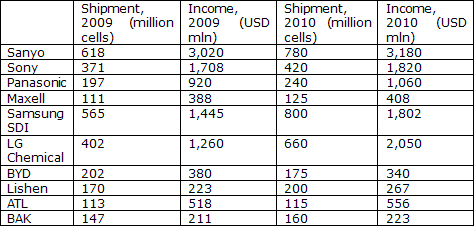
Power rechargeable lithium batteries have aroused wide attention due to the popularity of low-carbon economy concept. However, the shipment of power rechargeable lithium battery is still low, and manufacturers are suffering serious loss. For example, A123 Systems and ENER1 have suffered deep loss, and the gross margin has dropped for five consecutive years. Thus, investing in these companies is highly risky, like gambling. The performance of downstream enterprises is not good, and the investment mainly concentrates on the upstream of the rechargeable lithium battery industry. In China, any stock with a few relations with the rechargeable lithium battery upstream will gain dramatically.
The rechargeable lithium battery industry chain is long and extensive. The four major raw materials for rechargeable lithium battery by cost attribution are anode material, separator, electrolyte and cathode material.
At present, anode material is the hottest topic. Non-power rechargeable lithium battery batteries usually adopt LiCo2O4 as anode material. However, the anode material of power lithium battery is categorized into LiMn2O4 and LiFePO4. Japanese manufacturers mainly specialize in LiMn2O4, and have successively issued several electric cars with LiMn2O4 battery. Nevertheless, the United States and China’s manufacturers focus on LiFePO4, and A123 is a LiFePO4 leader. LiFePO4 is excellent in performance and safety, but it is inferior to LiMn2O4 in terms of industrialized maturity, cost and consistency. The rechargeable lithium battery of an electric vehicle is connected by tens even hundreds of cells, and hence has high consistency requirement which is rather difficult for LiFePO4 to achieve. Thus, nearly all large auto manufacturers select LiMn2O4 due to its higher maturity. Even A123, the leader in LiFePO4 battery field, also failed to win the Chevrolet tender. However, LG Chemical, a big LiMn2O4 battery manufacturer, had won the bid. Now, the frequent auto recalls make auto manufacturers behave extremely cautious that they won’t have a test for LiFePO4 battery manufacturers. Furthermore, the maturity of LiMn2O4 is no more than five years, let alone LiFePO4.
At present, the major anode material manufacturers are from Japan and Europe. Umicore is a large Belgium’s corporation with annual income of USD10 billion, and has main production bases in South Korea. In 2010, thanks to the sharp demand from South Korea’s LG Chemical and Samsung SDI, Umicore surpassed Japan's Nichia to become the world’s largest rechargeable lithium battery anode material company, with over 30% market shares. However, the rechargeable lithium battery anode material only accounted for less than 10% of Umicore’s income. Nichia, the world’s biggest LED manufacturer, also the world’s largest rechargeable lithium battery anode manufacturer by 2010, holds more than 20% market shares. Rechargeable lithium battery anode material has various categories, so there are many manufacturers involved in the field, especially Japan’s manufacturers such as Toda Kogyo, AGC SEIMI, SEIDO, Tanaka-Chem, JFE Mining, Mitsubishi Chemical, Nitto Denko, Mitsubishi Mining, Sumitomo Osaka Cement and Nippon Chemical Industrial, all of which have held around 50% shares. China’s major manufacturers include Beijing Easpring Co., Ltd., Shanshan Holding Company, Hunan Reshine New Material Co., Ltd., Ningbo Jinhe New materials Co., Ltd, CITIC GUOAN Mengguli and Tianjin B&M Science and Technology Joint-Stock Ltd., with total market share of 11%. BYD, a large electric vehicle manufacturer of China, purchases LiFePO4 batteries from Tianjin STL Energy Technology Co., Ltd. Now, only Japan’s rechargeable lithium battery manufacturers are capable of producing anode materials by themselves.
The separator market is dominated by three magnates, i.e. Asahi Kasei Corporation, Tonen Chemical and Celgard, with the total market shares exceeding 75%. As a big chemical plant in Japan, Asahi Kasei Corporation possesses annual revenue surpassing US$16 billion, but the separator business contributes less than 5% to its total revenue. Tonen Chemical, the big oil refinery in Japan, is subordinated to the global largest oil refinery-Exxon Mobil, and the revenue from separator accounts for less than 1% of the company’s total revenue. Celgard belongs to America’s Polypore International Inc.
As for the cathode materials field, Hitachi Chemical holds the world’s No.1 market share of 35%. Hitachi Chemical is a member of Hitachi Ltd. and its annual revenue is very close to US$5 billion, while the contribution of cathode business to the company’s total revenue is lower than 3%. Nippon Carbon ranks the second with the market share of nearly 20%. However, the market of cathode materials is very mature, and hence hasn’t gotten much attention.
In regard to the electrolyte field, the top three manufacturers enjoy a total market share of approximate 70%. Subordinated to Samsung Group, Chiel Industries is the world’s largest manufacturer of rechargeable lithium battery electrolyte as well as the largest clothing enterprise in South Korea. Benefiting from the substantially increased demand of LG Chem and Samsung SDI, Chiel Industries surpassed Japan’s Ube in 2010 and became the global No.1 with the market share of 33%. Ube, whose annual revenue is more than US$6 billion, has a wide product scope, ranging from aluminum wheel hub to pharmaceuticals and from coal washer to electrolyte. Japan’s Mitsubishi Chemical and Tomiyama Pure Chemical take the third and fourth positions respectively. Lithium hexafluorophosphate, the vital raw material of electrolyte, is almost monopolized by Japanese manufacturers such as Stella Chemical, Kanto Denka and SUTERAKEMIFA.
Compared with the rechargeable lithium battery upstream manufacturers in China, almost all of the overseas manufacturers are super-big plants with the annual revenue usually surpassing US$1 billion. On the contrary, Chinese manufacturers are generally new entrants relying on bank loans and most of them have the annual revenue less than US$100 million. Rechargeable lithium battery hybrid vehicles or electric vehicles are slowly promoted, while the upstream rechargeable lithium battery industry in China has been confronted with overcapacity.
ViaResearchinchina
BYD is the only manufacturer witnessing drop in both shipment and income for three consecutive years, and it has attached more importance to automotive than to rechargeable lithium battery. In the meantime, South Korean manufacturers have made rapid progress. Samsung SDI is projected to top the world by shipment and rank the fourth place by income in 2010. LG Chemical is likely to be in the second place.
Shipment & Income of World’s Major Lithium Secondary Battery Manufacturers, 2009-2010

Power rechargeable lithium batteries have aroused wide attention due to the popularity of low-carbon economy concept. However, the shipment of power rechargeable lithium battery is still low, and manufacturers are suffering serious loss. For example, A123 Systems and ENER1 have suffered deep loss, and the gross margin has dropped for five consecutive years. Thus, investing in these companies is highly risky, like gambling. The performance of downstream enterprises is not good, and the investment mainly concentrates on the upstream of the rechargeable lithium battery industry. In China, any stock with a few relations with the rechargeable lithium battery upstream will gain dramatically.
The rechargeable lithium battery industry chain is long and extensive. The four major raw materials for rechargeable lithium battery by cost attribution are anode material, separator, electrolyte and cathode material.
At present, anode material is the hottest topic. Non-power rechargeable lithium battery batteries usually adopt LiCo2O4 as anode material. However, the anode material of power lithium battery is categorized into LiMn2O4 and LiFePO4. Japanese manufacturers mainly specialize in LiMn2O4, and have successively issued several electric cars with LiMn2O4 battery. Nevertheless, the United States and China’s manufacturers focus on LiFePO4, and A123 is a LiFePO4 leader. LiFePO4 is excellent in performance and safety, but it is inferior to LiMn2O4 in terms of industrialized maturity, cost and consistency. The rechargeable lithium battery of an electric vehicle is connected by tens even hundreds of cells, and hence has high consistency requirement which is rather difficult for LiFePO4 to achieve. Thus, nearly all large auto manufacturers select LiMn2O4 due to its higher maturity. Even A123, the leader in LiFePO4 battery field, also failed to win the Chevrolet tender. However, LG Chemical, a big LiMn2O4 battery manufacturer, had won the bid. Now, the frequent auto recalls make auto manufacturers behave extremely cautious that they won’t have a test for LiFePO4 battery manufacturers. Furthermore, the maturity of LiMn2O4 is no more than five years, let alone LiFePO4.
At present, the major anode material manufacturers are from Japan and Europe. Umicore is a large Belgium’s corporation with annual income of USD10 billion, and has main production bases in South Korea. In 2010, thanks to the sharp demand from South Korea’s LG Chemical and Samsung SDI, Umicore surpassed Japan's Nichia to become the world’s largest rechargeable lithium battery anode material company, with over 30% market shares. However, the rechargeable lithium battery anode material only accounted for less than 10% of Umicore’s income. Nichia, the world’s biggest LED manufacturer, also the world’s largest rechargeable lithium battery anode manufacturer by 2010, holds more than 20% market shares. Rechargeable lithium battery anode material has various categories, so there are many manufacturers involved in the field, especially Japan’s manufacturers such as Toda Kogyo, AGC SEIMI, SEIDO, Tanaka-Chem, JFE Mining, Mitsubishi Chemical, Nitto Denko, Mitsubishi Mining, Sumitomo Osaka Cement and Nippon Chemical Industrial, all of which have held around 50% shares. China’s major manufacturers include Beijing Easpring Co., Ltd., Shanshan Holding Company, Hunan Reshine New Material Co., Ltd., Ningbo Jinhe New materials Co., Ltd, CITIC GUOAN Mengguli and Tianjin B&M Science and Technology Joint-Stock Ltd., with total market share of 11%. BYD, a large electric vehicle manufacturer of China, purchases LiFePO4 batteries from Tianjin STL Energy Technology Co., Ltd. Now, only Japan’s rechargeable lithium battery manufacturers are capable of producing anode materials by themselves.
The separator market is dominated by three magnates, i.e. Asahi Kasei Corporation, Tonen Chemical and Celgard, with the total market shares exceeding 75%. As a big chemical plant in Japan, Asahi Kasei Corporation possesses annual revenue surpassing US$16 billion, but the separator business contributes less than 5% to its total revenue. Tonen Chemical, the big oil refinery in Japan, is subordinated to the global largest oil refinery-Exxon Mobil, and the revenue from separator accounts for less than 1% of the company’s total revenue. Celgard belongs to America’s Polypore International Inc.
As for the cathode materials field, Hitachi Chemical holds the world’s No.1 market share of 35%. Hitachi Chemical is a member of Hitachi Ltd. and its annual revenue is very close to US$5 billion, while the contribution of cathode business to the company’s total revenue is lower than 3%. Nippon Carbon ranks the second with the market share of nearly 20%. However, the market of cathode materials is very mature, and hence hasn’t gotten much attention.
In regard to the electrolyte field, the top three manufacturers enjoy a total market share of approximate 70%. Subordinated to Samsung Group, Chiel Industries is the world’s largest manufacturer of rechargeable lithium battery electrolyte as well as the largest clothing enterprise in South Korea. Benefiting from the substantially increased demand of LG Chem and Samsung SDI, Chiel Industries surpassed Japan’s Ube in 2010 and became the global No.1 with the market share of 33%. Ube, whose annual revenue is more than US$6 billion, has a wide product scope, ranging from aluminum wheel hub to pharmaceuticals and from coal washer to electrolyte. Japan’s Mitsubishi Chemical and Tomiyama Pure Chemical take the third and fourth positions respectively. Lithium hexafluorophosphate, the vital raw material of electrolyte, is almost monopolized by Japanese manufacturers such as Stella Chemical, Kanto Denka and SUTERAKEMIFA.
Compared with the rechargeable lithium battery upstream manufacturers in China, almost all of the overseas manufacturers are super-big plants with the annual revenue usually surpassing US$1 billion. On the contrary, Chinese manufacturers are generally new entrants relying on bank loans and most of them have the annual revenue less than US$100 million. Rechargeable lithium battery hybrid vehicles or electric vehicles are slowly promoted, while the upstream rechargeable lithium battery industry in China has been confronted with overcapacity.
ViaResearchinchina
 Similar topics
Similar topics» Global & China Li-Battery Industry Summit 2011
» Samsung SDI Ascends to Global no.1 in Rechargeable Battery
» Galaxy identifies site for lithium-ion battery plant in China
» Sanyo aims to grab 40% share in global eco-car battery market in 2020
» Develop Battery Cathodes from Byproducts of the Paper Industry and Pulp
» Samsung SDI Ascends to Global no.1 in Rechargeable Battery
» Galaxy identifies site for lithium-ion battery plant in China
» Sanyo aims to grab 40% share in global eco-car battery market in 2020
» Develop Battery Cathodes from Byproducts of the Paper Industry and Pulp
Page 1 of 1
Permissions in this forum:
You cannot reply to topics in this forum

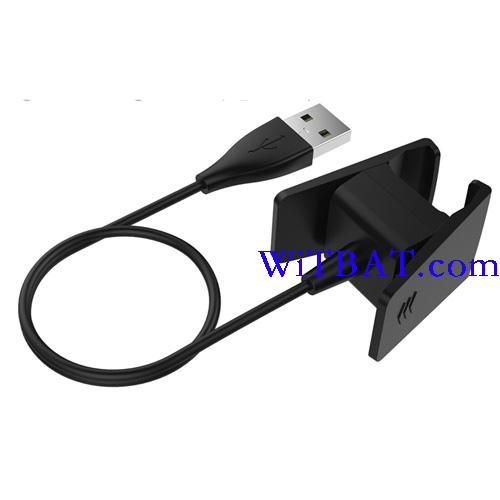


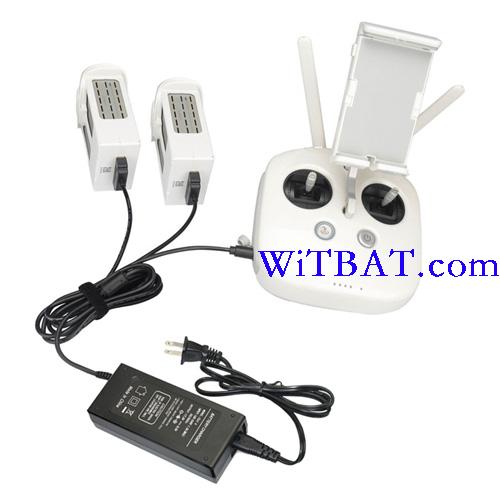
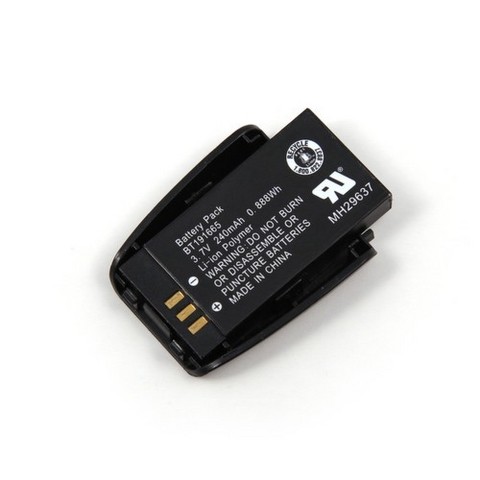
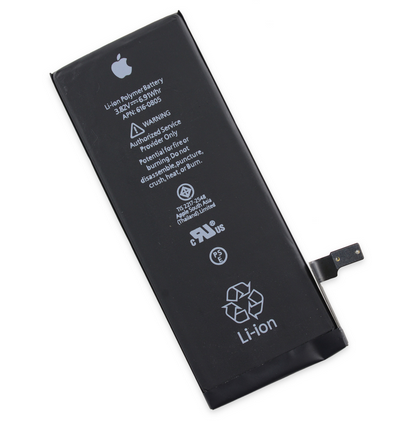






» NIO Phone 2 Smartphone Battery NBET02
» Mercedes Becker Map Pilot Battery HJS100
» Braun Silk-épil 9 Flex Type 5380 Epilator Battery
» Samsung Galaxy Tab Active Tablet PC Battery EB-BT365BBU
» Samsung Galaxy Tab Active 3 SM-T570 Tablet PC Battery EB-BT575BBE